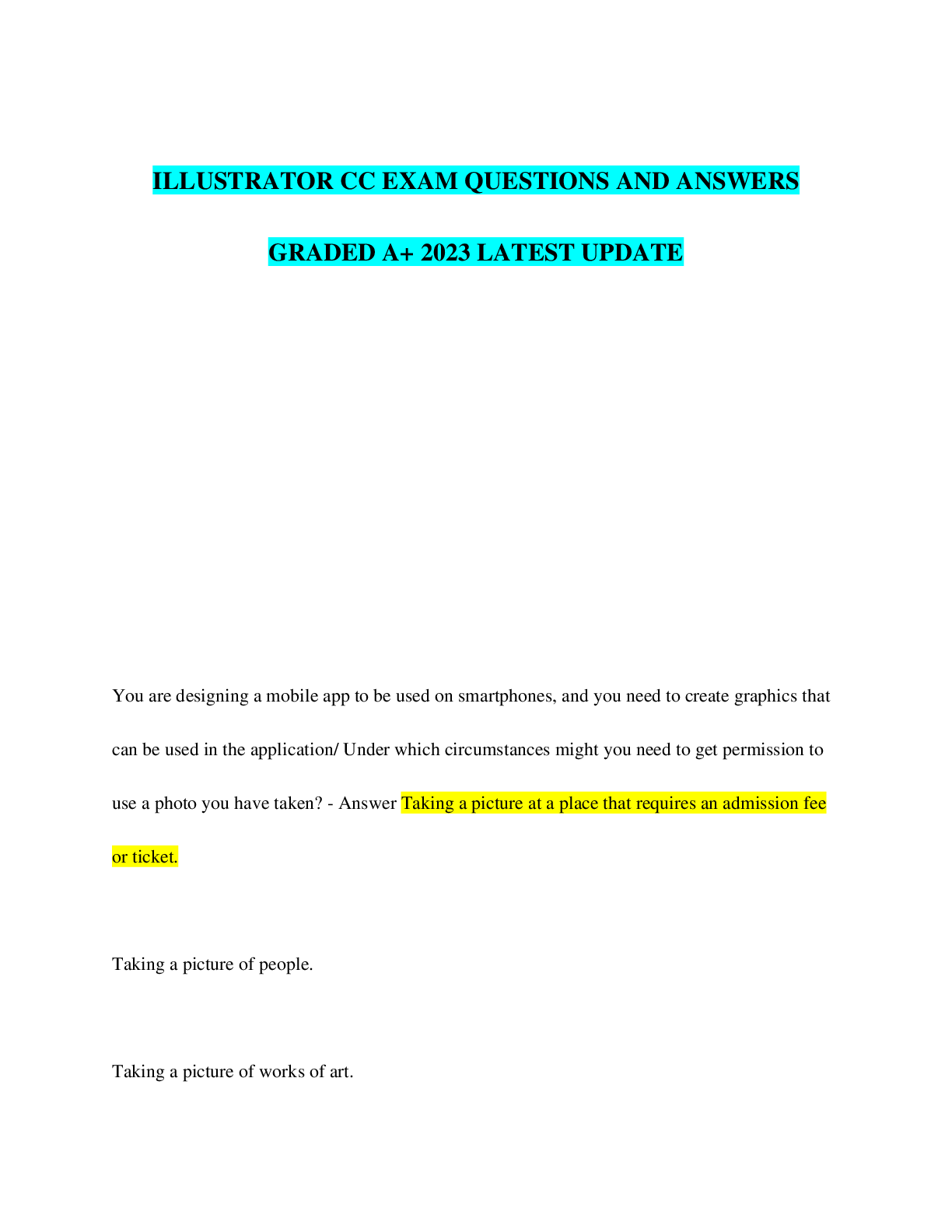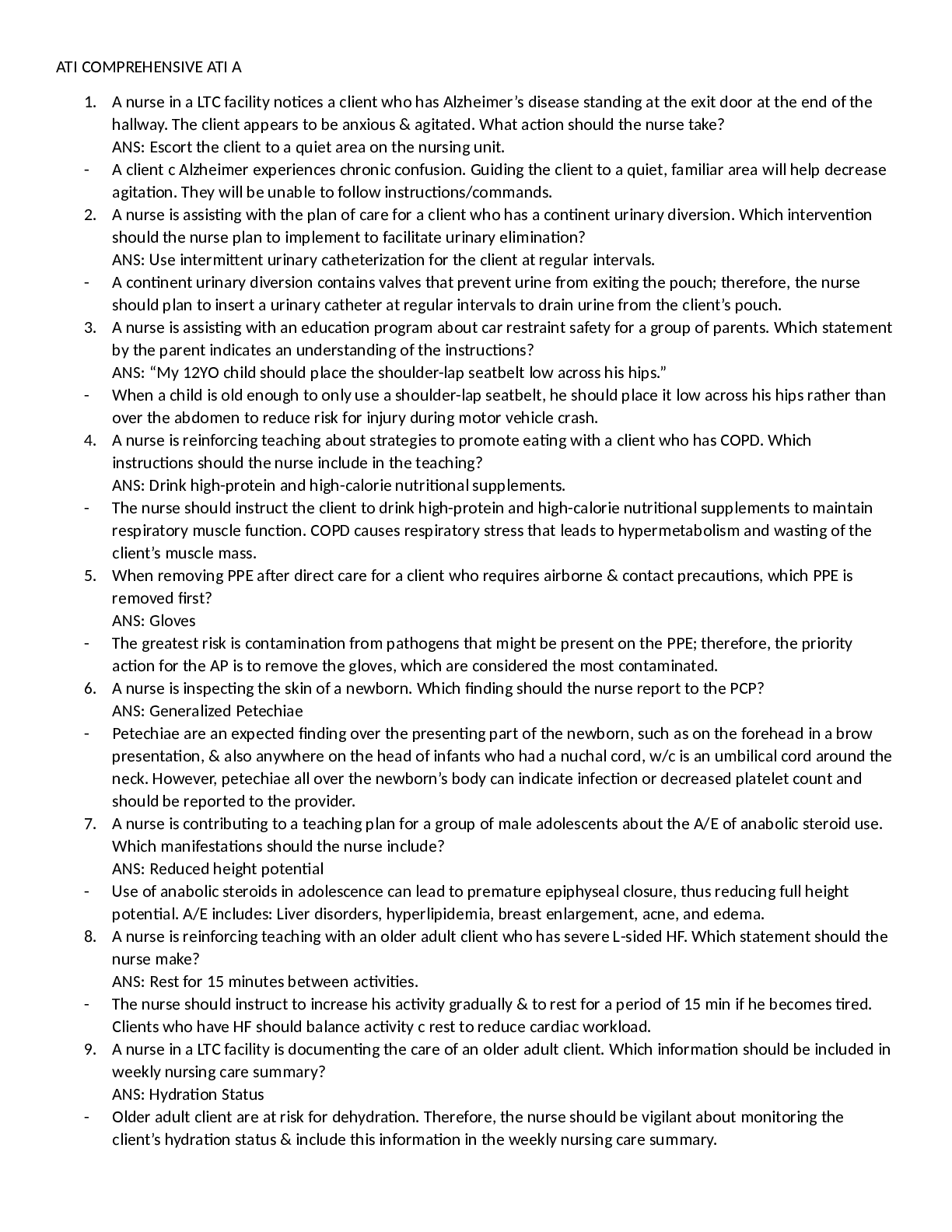
The NCLEX Questions-Pharmacology (with Rationales) resource
$ 13.5

Illustrator CC Exam 70 Questions And Answers Graded A+
1. A nurse in a LTC facility notices a client who has Alzheimer’s disease standing at the exit door at the end of the hallway. The client appears to be anxious & agitated. What action should the nu ... rse take? ANS: Escort the client to a quiet area on the nursing unit. - A client c Alzheimer experiences chronic confusion. Guiding the client to a quiet, familiar area will help decrease agitation. They will be unable to follow instructions/commands. 2. A nurse is assisting with the plan of care for a client who has a continent urinary diversion. Which intervention should the nurse plan to implement to facilitate urinary elimination? ANS: Use intermittent urinary catheterization for the client at regular intervals. - A continent urinary diversion contains valves that prevent urine from exiting the pouch; therefore, the nurse should plan to insert a urinary catheter at regular intervals to drain urine from the client’s pouch. 3. A nurse is assisting with an education program about car restraint safety for a group of parents. Which statement by the parent indicates an understanding of the instructions? ANS: “My 12YO child should place the shoulder-lap seatbelt low across his hips.” - When a child is old enough to only use a shoulder-lap seatbelt, he should place it low across his hips rather than over the abdomen to reduce risk for injury during motor vehicle crash. 4. A nurse is reinforcing teaching about strategies to promote eating with a client who has COPD. Which instructions should the nurse include in the teaching? ANS: Drink high-protein and high-calorie nutritional supplements. - The nurse should instruct the client to drink high-protein and high-calorie nutritional supplements to maintain respiratory muscle function. COPD causes respiratory stress that leads to hypermetabolism and wasting of the client’s muscle mass. 5. When removing PPE after direct care for a client who requires airborne & contact precautions, which PPE is removed first? ANS: Gloves - The greatest risk is contamination from pathogens that might be present on the PPE; therefore, the priority action for the AP is to remove the gloves, which are considered the most contaminated. 6. A nurse is inspecting the skin of a newborn. Which finding should the nurse report to the PCP? ANS: Generalized Petechiae - Petechiae are an expected finding over the presenting part of the newborn, such as on the forehead in a brow presentation, & also anywhere on the head of infants who had a nuchal cord, w/c is an umbilical cord around the neck. However, petechiae all over the newborn’s body can indicate infection or decreased platelet count and should be reported to the provider. 7. A nurse is contributing to a teaching plan for a group of male adolescents about the A/E of anabolic steroid use. Which manifestations should the nurse include? ANS: Reduced height potential - Use of anabolic steroids in adolescence can lead to premature epiphyseal closure, thus reducing full height potential. A/E includes: Liver disorders, hyperlipidemia, breast enlargement, acne, and edema. 8. A nurse is reinforcing teaching with an older adult client who has severe L-sided HF. Which statement should the nurse make? ANS: Rest for 15 minutes between activities. - The nurse should instruct to increase his activity gradually & to rest for a period of 15 min if he becomes tired. Clients who have HF should balance activity c rest to reduce cardiac workload. 9. A nurse in a LTC facility is documenting the care of an older adult client. Which information should be included in weekly nursing care summary? ANS: Hydration Status - Older adult client are at risk for dehydration. Therefore, the nurse should be vigilant about monitoring the client’s hydration status & include this information in the weekly nursing care summary. 10. A nurse is caring for a client who has a head injury. Using the Glasgow Coma Scale to collect data, the nurse should obtain which information? ANS: Motor Response - The nurse should collect data about the client’s motor response & assign the response a score of 1-6, according to the Glasgow Coma Scale. [Show More]
Last updated: 3 years ago
Preview 1 out of 25 pages

Buy this document to get the full access instantly
Instant Download Access after purchase
Buy NowInstant download
We Accept:

Can't find what you want? Try our AI powered Search
Connected school, study & course
About the document
Uploaded On
Jul 07, 2021
Number of pages
25
Written in
All
This document has been written for:
Uploaded
Jul 07, 2021
Downloads
0
Views
140
Scholarfriends.com Online Platform by Browsegrades Inc. 651N South Broad St, Middletown DE. United States.
We're available through e-mail, Twitter, Facebook, and live chat.
FAQ
Questions? Leave a message!
Copyright © Scholarfriends · High quality services·